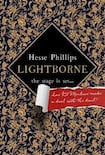
Lightborne, a first novel by Hesse Phillips, is the latest in a long line of fictional treatments of the events that led to the killing of the Elizabethan playwright Christopher Marlowe (1564-1593).
Marlowe’s biography exerts a powerful pull. Recruited as a spy while a scholarship boy at Cambridge, he went on to write dramas of unprecedented force, featuring protagonists who pursue their heart’s desire to the point of ruin. Informed on and arrested for his allegedly “monstrous opinions” concerning religion and homosexuality, he was shortly afterwards fatally stabbed above the eye by an associate from the espionage underworld at a private lodging house in Deptford, with other such associates present. Whether a drunken brawl or an assassination arranged by higher-ups to settle Marlowe’s case, the incident may have occurred during a stopover in a bid to flee England.
The afterword to Lightborne claims Marlowe as a “queer ancestor” (an established tradition), and the novel offers a thoroughly contemporary take on his predicament. Phillips links not only Marlowe’s killing, but also the great conspiracy of his time, the Jesuit “Babington Plot” against Elizabeth I, to betrayed homosexual love. Such love was thwarted — the novel suggests — by a culture in which forms of pederastic abuse were tolerated and even deployed in covert efforts to protect the Tudor monarchy, which staked its legitimacy on Anglican conformity.
Also contemporary is Lightborne’s approach to historical reconstruction. It wears a Renaissance register casually, like a hipster accessory. A fast-paced narrative chain of theatrical scenes breathes new life into familiar images of the period, though some clearer orientation may be needed for readers unacquainted with the context.
READ MORE
In Edward II (to which Lightborne’s title alludes), Marlowe certainly affirmed homosexual desire beyond the limits then set by aristocratic and literary codes. He implied that such a gesture risked ultimate punishment. This transgression of boundaries and exposure to persecution, make Marlowe, so Phillips puts it, “someone like me” — that is, aligned with a present-day politics of identity. In a running riff on this concept, the novel always assigns Marlowe inner substance. He is “a subtler creature” than his own overreaching fictional creations. Tamburlaine, the favourite hero of his public, he labels a “clown.”
Far different from the “empty,” “hollow” torturers in the nascent, very nasty security state of which he too is a functionary, Lightborne’s Marlowe would never kill the thing he loved. By the end, Phillips has also given that Wildean motif an update.













